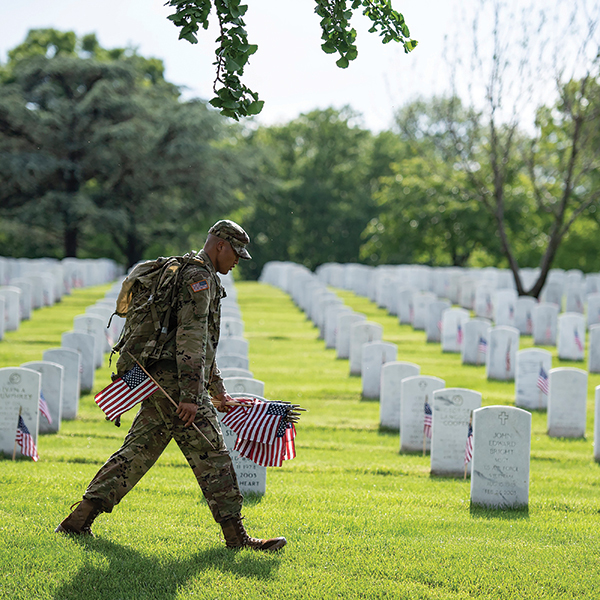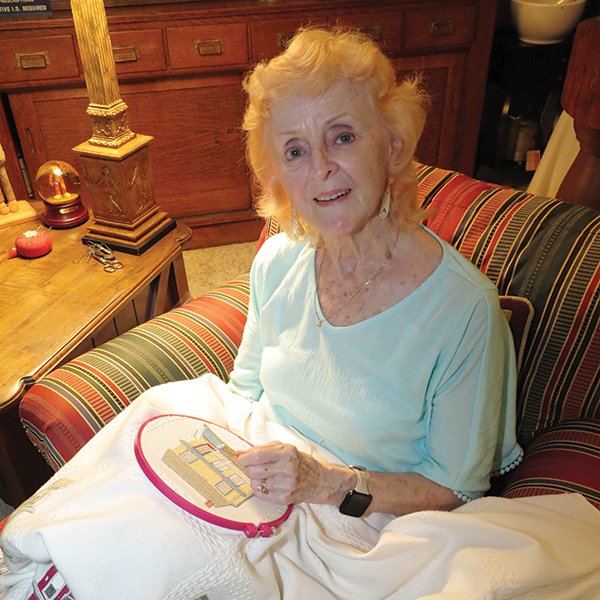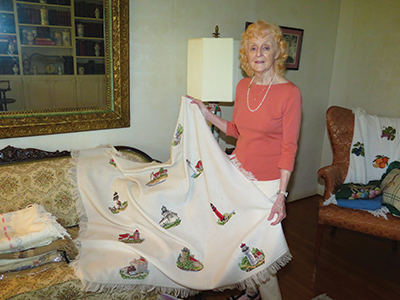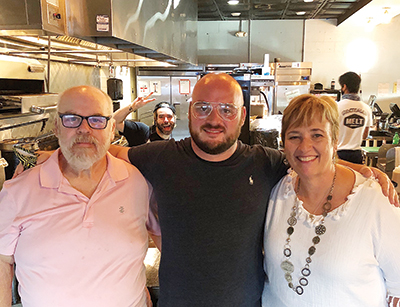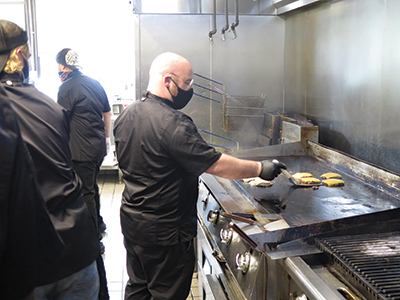A special way to honor those who served
Story by Leigh Pritchett
Photos courtesy of Jerry W. Garrett Jr. and John Bryant
Submitted Photos
During the Christmas season this year, it will be a time to reflect on the gift of freedom and to pay tribute to those who secured it.
At 11 a.m. Dec. 19 at St. Clair Memorial Gardens, the second annual Wreaths Across America (WAA) observance will place wreaths at gravesites of veterans.
Hundreds of wreaths will be put on veteran graves at St. Clair Memorial Gardens, Valley Hill Cemetery, Oak Ridge Cemetery and elsewhere in the county, said Mindy and Keaton Manners and Julia Skelton, local WAA organizers.
The first WAA event in St. Clair County was Dec. 14, 2019. That morning, families, friends and volunteers placed 300 live, evergreen wreaths on veteran graves as part of a nationwide effort.
“Each year, millions of Americans come together to remember the fallen, honor those that serve and their families, and teach the next generation about the value of freedom,” notes the national WAA organization. “This gathering of volunteers and patriots takes place in local and national cemeteries in all 50 states” and some American cemeteries in Europe. “… In 2019, approximately 2.2 million veteran wreaths were placed on headstones at 2,158 participating locations around the country in honor of the service and sacrifices made for our freedoms.”
Broken Arrow Chapter of the Daughters of the American Revolution (DAR), along with Steve Perry and Usrey Funeral Home, worked to bring the local event together. Giving their assistance were St. Clair County High School JROTC, Canoe Creek Society of Children of the American Revolution (CAR), Henderson Builders Supply Co. in Pell City and numerous residents of Col. Robert L. Howard State Veterans Home.
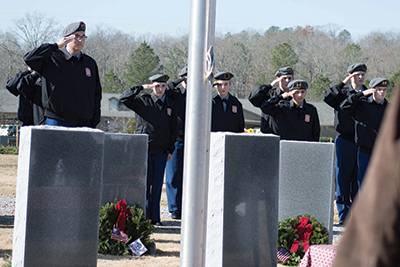
Susan Bowman of Pell City was touched by the number of wreaths and the number of people who came to help place those wreaths.
This was her first time to be part of such an observance.
She got to place wreaths at the graves of her father, Jesse Hooks, and her sister, Kathy Lynn Hooks, both of whom had served in the Army.
“I was very proud and teary-eyed. I was very teary-eyed,” she said. “Just emotions running through me.”
Those same words would describe the writer of this article and her sisters as well. Only two months before WAA, our dad – retired Chief Master Sgt. Porter Bailey – had been buried with military honors.
Getting to place a WAA wreath at his gravesite stirred the pangs of grief. But it also filled our hearts with pride for the 37 years he served this nation in the Army, Air Force and Alabama Air National Guard.
The day brought emotional extremes for Lyle and Shelly Harmon, who are the parents of three sons.
Well in advance of the ceremony, Harmon – who is St. Clair County’s district attorney and chief warrant officer 4 with Alabama Army National Guard – had agreed to serve as master of ceremonies. Then, hardly a month before the observance, son Sloan (known as “Boo”) was fatally shot just off an I-20 exit.
An airman first class with the Air Force, Boo was a KC-135 crew chief at the Alabama Air National Guard’s 117th Air Refueling Wing in Birmingham. He had just turned 20 a few days before the murder.
Though serving as WAA master of ceremonies so soon after Boo’s death was difficult, “I felt I should,” Lyle Harmon said. “… I can’t even express how humbling that was to do that. … It was quite humbling.”
At the same time, it was “a huge honor,” Harmon added.
During the ceremony, veterans of the Army, Marines, Navy, Coast Guard and Merchant Marines each placed a wreath at the respective monuments that stand at St. Clair Memorial Gardens. Because the veteran who was to place the wreath at the Air Force monument could not attend, Shelly Harmon did it.
Lyle Harmon watched his wife – a grieving, heartbroken mother – place a wreath of tribute at the Air Force monument.
Thinking back on what Shelly did that day, Harmon recalled, “I’m just so proud of my wife. She is unbelievably faithful and strong.”
The origin
The simple request of another grieving mother was the catalyst for the local WAA observance.
In early summer of 2019, that mother contacted a DAR group in Birmingham, explaining that she was unable to place a wreath or flag for Memorial Day on her son’s grave in St. Clair Memorial Gardens. Mrs. Manners – a member of Broken Arrow DAR in Pell City – and her husband volunteered to lay the wreath.
When Mr. and Mrs. Manners went for that reason to St. Clair Memorial Gardens, which is the only cemetery in the county with a section specifically for the military, the couple were surprised by the number of veterans’ graves they saw.
In the two-mile trip from the cemetery back to their home, Manners – an Army veteran – and Mrs. Manners decided they must organize a tribute to veterans interred there.
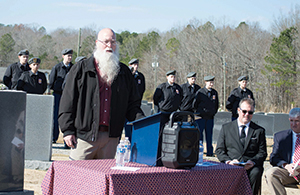
For about six years, the couple had attended WAA observances at Alabama National Cemetery in Montevallo. Now, they felt it was time to bring that tribute to St. Clair County.
They set a goal of 300 wreaths, 260 of which would be for St. Clair Memorial Gardens. The remainder would go to graves in Valley Hill Cemetery, Oak Ridge Cemetery and Broken Arrow Cemetery at the request of various families.
St. Clair County High School JROTC joined the effort, raising funds for 100 wreaths and providing military color guard for the ceremony.
The JROTC leaders, Retired Maj. Channing McGee and Retired Sgt. 1st Class Vicki Glover, said participating in WAA “teaches cadets the importance of community service and instills patriotism by honoring these veterans and their sacrifice.”
For the 2020 event, the cadets plan to provide another 100 wreaths. (For information on how to help the cadets meet their goal, see the accompanying story, “Sponsor a wreath.”)
St. Clair debut
The first WAA event in St. Clair County was met with such support in the community that the entire ceremony was finalized within three months, the Manners said.
But the enthusiasm following the event brought the 2020 ceremony together even quicker.
“Two days after this past event, we had it all lined up for this year,” he said.
This year’s event will also feature a replica of the Tomb of the Unknown Soldier. (For more information, read the accompanying story, “Tomb of the Unknown Soldier replica to be on display.”)
After attending last year’s WAA, John Bryant of Alpine encouraged fellow members of the Knights of Columbus, Assembly 2972, Our Lady of the Lake to volunteer to lay wreaths of remembrance on graves of fallen heroes and to honor those who served the nation.
“I can’t think of anything that shows more patriotism than to honor and to show respect for our veterans,” Bryant said. “… I feel like we need more patriotism. We need to let this country know we love it, and we need to remember that the privileges we have today are because of our veterans.”
Skelton, who is also a member of Broken Arrow DAR, said volunteers will be needed to help place wreaths at St. Clair Memorial Gardens and possibly at Valley Hill Cemetery and Oak Ridge Cemetery.
Wreath placement generally is guided by military designations on headstones or footstones. However, Mrs. Manners said wreath-placement requests can be made for veterans whose grave markers have no military designation. A copy of the veteran’s DD-214 or a photo of the veteran in uniform will suffice as proof of military service.
Editor’s Note: To request wreath placement and provide documentation, email Mrs. Manners at mindy.manners@yahoo.com.











